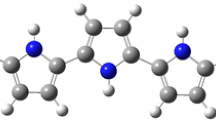Abstract
The carboranylpyrrole polymers are functional materials with superior thermal resistance and conducting performances. The carboranylpyrrole structures and Laplacian bond order (LBO) of carborane moiety, as well as the thermal resistance and conducting properties of carboranylpyrrole dimers or polymers, were investigated theoretically. The 11B NMR chemical shifts of 3-(2-methyl-o-carboranyl)alkyl-1H-pyrrole monomers (CP-1 to CP-5) were calculated and analyzed. The average LBO values of some characteristic chemical bonds in the carborane cages of CP-1 to CP-5 molecules were calculated. It is found that the average LBO values of carborane moieties change slightly with the increase in alkyl chain length. The temperature resulting in about 15–20 % weight loss for CP-1, CP-3, CP-4 and CP-5 polymers is predicted to be more than 700 °C. Apart from the C–C bonds in carborane moieties of 3-(2-R-o-carboranyl)propyl-1H-pyrrole (R = CH2OH, CH2OCH3, CN, COCl, Ph) substituents, the LBO values of other bonds in these cages change slightly relative to that in the molecule of 3-(2-methyl-o-carboranyl)propyl-1H-pyrrole (CP-3). The C–C bond LBO values in the carborane cages of these substituents with electron-donating groups (R = CH2OH, CH2OCH3) are bigger than that in CP-3, while those values in those substituents with electron-withdrawing groups (R = CN, COCl, Ph) are smaller than that in CP-3. The polymerization activity calculated for CP-1 to CP-5 monomers increases with the increase in alkyl chain length. The calculated orbital energy gap (∆E LUMO−HOMO) of CP-1 to CP-5 dimers decreases with the increase in alkyl chain length, and accordingly, the electronic conductivity has the potential to increase. In addition, the calculated band gaps of CP-1 to CP-5 dimers cell models also decrease with the increase in alkyl chain length.





Similar content being viewed by others
References
Furstner A (2003) Angew Chem Int Ed 42:3582–3603
Satapathy R, Dash BP, Zheng C, Maguire JA, Hosmane NS (2011) J Org Chem 76:3562–3565
Lee D, Swager TM (2003) J Am Chem Soc 125:6870–6871
Kamran M, Ullah H, Shah AA, Bilal S, Tahir AA, Ayub K (2015) Polymer 72:30–39
Fabre B, Chayer S, Vicente MGH (2003) Electrochem Commun 5:431–434
Fabre B, Clark JC, Vicente MGH (2006) Macromolecules 39:112–119
Chayer S, Jaquinod L, Smith KM, Vicente MGH (2001) Tetrahedron Lett 42:7759–7761
Clark JC, Fronczek FR, Vicente MGH (2005) Tetrahedron Lett 46:2365–2368
Oliva JM, Klein DJ, Schleyer PvR, Serrano-Andrés L (2009) Pure Appl Chem 81:719–729
Glukhov IV, Antipin MY, Lyssenko KA (2004) Eur J Inorg Chem 2004:1379–1384
Glukhov IV, Lyssenko KA, Antipin MY (2007) Struct Chem 18:465–469
Smith SG, Paton RS, Burton JW, Goodman JM (2008) J Org Chem 73:4053–4062
Pallier C, Leyssale JM, Truflandier LA (2013) Chem Mater 25:2618–2629
Lu T, Chen FW (2013) J Phys Chem A 117:3100–3108
Lu T, Chen FW (2012) J Comp Chem 33:580–592
Frisch MJ, Trucks GW, Schlegel HB, Scuseria GE, Robb MA, Cheeseman, JR, Scalmani G, Barone V, Mennucci B, Petersson G. A, Nakatsuji H, Caricato M, Li X, Hratchian HP, Izmaylov AF, Bloino J, Zheng G, Sonnenberg JL, Hada M, Ehara M, Toyota K, Fukuda R, Hasegawa J, Ishida M, Nakajima T, Honda Y, Kitao O, Nakai H, Vreven T, Montgomery JAJ, Peralta JE, Ogliaro F, Bearpark M, Heyd JJ, Brothers E, Kudin KN, Staroverov VN, Kobayashi R, Normand J, Raghavachari K, Rendell A, Burant JC, Iyengar SS, Tomasi J, Cossi M, Rega N, Millam JM, Klene M, Knox JE, Cross JB, Bakken V, Adamo C, Jaramillo J, Gomperts R, Stratmann RE, Yazyev O, Austin AJ, Cammi R, Pomelli C, Ochterski JW, Martin RL, Morokuma K, Zakrzewski VG, Voth GA, Salvador P, Dannenberg JJ, Dapprich S, Daniels AD, Farkas O, Foresman JB, Ortiz JV, Cioslowski J, Fox DJ (2009) Gaussian 09, Revision A.02. Gaussian, Wallingford
Acknowledgments
This project was financially supported by NSAF (U1430127).
Author information
Authors and Affiliations
Corresponding author
Rights and permissions
About this article
Cite this article
Ge, Y., Li, T. & Shi, L. Theoretical investigation of carboranylpyrrole structures and the thermal resistance and conducting properties of carboranylpyrrole polymers. Struct Chem 27, 1061–1069 (2016). https://doi.org/10.1007/s11224-015-0725-2
Received:
Accepted:
Published:
Issue Date:
DOI: https://doi.org/10.1007/s11224-015-0725-2




